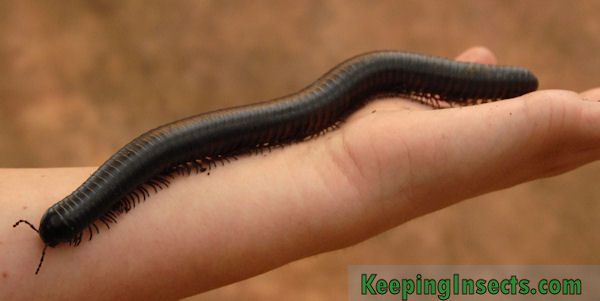Millipedes are not insects at all, but they do are popular invertebrate pets. That’s why this website also dedicates a page to these creatures! Here you can first read all about morphology, senses, life cycle and natural habitat of millipedes. On the bottom of the page you will find general tips and quick info about keeping millipedes as pets.

Archispirostreptus gigas – African Giant Black Millipede
Millipedes are part of the class Diplopoda. The are closely related to centipedes, class Chilopoda, and you could refer to millipedes and centipedes together as myriapods. Pill bugs are also related to millipedes but are actually isopod crustaceans and more related to shrimps, crabs and water fleas. There are around 10.000 species of millipedes on Earth.
Morphology of millipede
Millipedes have a peculiar body plan. Their body consists of many segments, each of these segments has two pairs of legs. On their head they have antennae, eyes and mouthparts. Their mouthparts are made for nibbling, like in stick insects, not for biting like in mantises or ants.
The difference between millipedes and centipedes is easy; millipedes have two pairs of legs per segment, eat plant material and are pretty docile. Centipedes have one pair of legs per segment, eat insects or other animals and most species can move pretty quickly.
The senses of a millipedes
It is believed that millipedes have the same senses as we do: sight, smell, hearing, taste and touch. But little is know about their senses and their accuracy. Millipedes have compound eyes with which they sense light, including ultraviolet light. They generally can feel sound with their body instead of hearing it with ears. Their antennae are used for the sense of taste and smell.
Development and life cycle
Millipedes are born out of eggs. Newborn millipedes don’t look exacly like their adult parents; they generally only have a few pairs of legs. When these little millipedes grow, they molt several times. With each consequtive molt the add segments and legs to their body, becoming more and more like the adults of their species.
Eggs are generally laid inside moist soil. A female can lay hundrerds of eggs in one go!
Natural habitat of millipedes
Millipedes occur in all continents (except Antarctica) and almost all countries. They generally live inside or just on top of the soil. The biggest species occur in the tropics. In temperate zones the millipedes generally become just 1 to 2 cm in lenght and are not kept as pets.
Keeping millipedes as pets
This general description for keeping millipedes holds for most millipede species, but not all. But sure to check the specific requirements for your species of millipede before you buy one.
Housing your millipedes
Millipedes need a terrarium or enclosure which is safe, escape proof and big enough. The size of the tank depends on how many millipedes you want to keep and and on their size. Generally speaking the tank should be at least 3 times the length of the largest millipede in all directions. If you have a lid on your tank you can reduce the height of the tank to 2x the lenght of the millipede. Without a lid millipedes can escape more easily than you might think, as they can climb well and can stretch themselves out pretty far. If you want to house multiple millipedes, be sure to add some space to the tank.
You need to provide your millipedes with a good substrate on the floor of the terrarium and with nice moist hiding places. As a substrate you can use potting earth or soil for your garden or forrest area. Put a layer of soil in the tank that is around 15 cm thick. As hiding places you can provide tree bark, half a coconut, grotto-like stones and old wood. Millipedes love moss to live on and hide under. They also eat the moss. By adding living moss to your terrarium you will add some nice green color and at the same time provide your millipedes with fresh food and hiding places.
Temperature and humidity
Adequate temperature and humidity are crucial to the survival of your millipedes. Millipedes generally like moist environments, so be sure to add enough water to the substrate of the terrarium. Be sure to check what temperature your species needs. Generally 25 degrees celsius should be good. You can provide this temperature by heating the tank with a lamp or a heat mat. More about this, you can read here.
Food for millipedes
Millipedes generally eat fruit, vegetables, mushrooms, moistened dry cat food, moistened fish food, rotting wood and rotting leaves. Not all species eat the same. Some species only live of specific food sources such as rotting woods, while others can live off anything.
You can feed your millipedes just by placing the food on top of the substrate. If the food goes bad easily, like fruit and vegetables, remove it before it starts to mold or rot.
